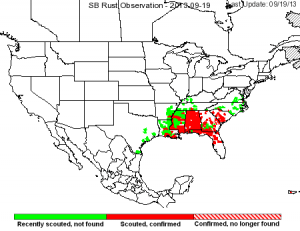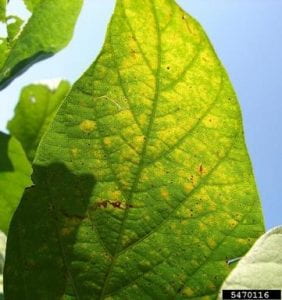Nathan Kleczewski, Extension Specialist – Plant Pathology; nkleczew@udel.edu
A new post has been added to the Field Crops Disease Management Blog: Sclerotinia Stem Blight of Soybeans
Soybean Rust
On September 17, 2013 soybean (SBR) rust was observed and confirmed on soybean leaves (10/34 leaflets, 2% leaf coverage) collected from one of the Tidewater AREC sentinel plots located in Suffolk County, Virginia (Figure 1). In 2013, SBR has been detected in 185 counties in 10 states in the U.S. including 61 counties in AL, 38 counties in MS, 34 counties in GA, 22 counties in FL, 13 counties in SC, 11 parishes in LA, two counties in AR and NC, and one county in both TN and VA.
 Figure 1. Current status of SBR as of September 19, 2013. SBR was reported in Suffolk County Virginia on September 17, 2013.
Figure 1. Current status of SBR as of September 19, 2013. SBR was reported in Suffolk County Virginia on September 17, 2013.
Most double crop beans are close to R6. Those at earlier stages of developmental stages may potentially be at risk if SBR makes it to Delaware very soon, or is already here at low levels, and the environment is conducive to disease development. However, these plants are also at risk for freeze injury. Right now my recommendation is to scout your beans to ensure that SBR is not present. I will gladly check out your fields upon request. Recent weather has not been conducive to disease development, but conditions could change in the near future. We are currently monitoring plots in Sussex and Newcastle Counties for SBR and I will post any updates as they occur on the Field Crops Disease Management Blog.
The following is a repeat of my article on SBR that I wrote last week with some slight modifications:
How to Scout for SBR
From R1 until R6 scout fields every week. Depending on the size of the field, five to 10 sections of 10-20 ft row length should be scouted. Ensure that sites are chosen throughout the field and are not focused on particular areas of the field (i.e. edges, areas near roads or entrance paths). One way to ensure that the field is properly covered is to scout in a zig-zag pattern. Pay attention to areas where humidity levels may be greater, such as those near tree lines, shaded locations, and bodies of water. Increase scouting frequency if forecasts indicate that SBR movement into the area is likely.
What to Look For
Focus on lower and middle portions of the canopy for symptoms of early stages of the disease. Using a hand lens, look for chlorosis and brown red-brown, or black pinpoint spots on the upper leaf surface. These are the early symptoms of the disease and they can be easily confused with other soybean diseases such as brown spot, frogeye leaf spot, bacterial pustule, bacterial blight, and downy mildew. Older infections may have raised, dusty, brown to red brown pustules that contain spores of the fungus. Sometimes it is easier to see disease symptoms if the leaf is held up to the sky (Figure 2) A helpful key to differentiating SBR from these other diseases can be found here: http://ohioline.osu.edu/sbr-fact/pdf/0001-English.pdf. Hard copies of this document are also available at the UD Plant Diagnostic lab and our Kent and Sussex county locations.
 Figure 2. Early symptoms of soybean rust may be easier to visualize if the leaf is backlit by sunlight. Image by Daren Mueller. Obtained from www.ipmimages.org.
Figure 2. Early symptoms of soybean rust may be easier to visualize if the leaf is backlit by sunlight. Image by Daren Mueller. Obtained from www.ipmimages.org.
SBR cannot be diagnosed in the field and can only be diagnosed in the laboratory. If you find suspect plants, collect 10-20 leaves and place them in a sealed plastic bag. Place a moist, but not soaking wet, paper towel in the bag. That same day samples should be sent to the UD Plant Diagnostic Clinic or your local UD Cooperative Extension office. Samples can be kept in the refrigerator overnight if they cannot be delivered on the same day.
SBR updates can be found on http://sbr.ipmpipe.org/cgi-bin/sbr/public.cgi
